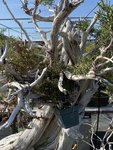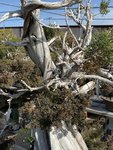@AverageBonsai - trees that have a good track record as landscape trees for your immediate neighborhood is a good place to start. Also trees that are native within 50 miles or 3000 ft elevation from you. Also local to you bonsai growers can help, of the top of my head I remember
@moke is from Utah. There are others here too, please chime in.
From the list of recommended landscape trees for Utah provided by
@Warpig , a few species jump out at me as being good for bonsai. A lot depends on your elevation. With regular water some of the high elevation species can grow quite a bit lower. Decided to just cut and paste, then added comments.
from the list for high elevation, above 6500 feet.
Rocky Mountain Juniper (Juniperus scopulorum)
Douglas Fir (Pseudotsuga menziesii)
Quaking Aspen (Populus tremuloides) - cottonwood and aspen have issues as bonsai, mostly big leaves that don't reduce enough and coarse branching.
Colorado Blue Spruce (Picea pungens) - very adaptable to lower elevations.
Limber Pine (Pinus flexilis) - excellent for bonsai, but may or may not work in your elevation.
Amur Maple (Acer ginnala) - excellent maple for bonsai, tolerates low humidity better than Japanese maple.
Bristlecone Pine (Pinus longaeva) - difficult horticulture, hard to keep alive long term in a pot. So slow growing that it is difficult to work as bonsai.
Korean Mountain Ash (Sorbus alnifolia) - any of the mountain ash Genus Sorbus - all make interesting bonsai, which ever one is sold locally is worth trying.
Englemann Spruce (Picea englemanii) - less adaptable than Colorado blue spruce, but fine and elegant foliage.
Valleys (~4000-6500 feet)
Common Hackberry (Celtis occidentalis) - excellent choice, can be used like a chinese elm
Bur Oak (Quercus macrocarpa) - slow to develop, large leaves on young trees, but with ramification leaves will reduce to less than 3 inches.
Rocky Mountain Juniper (Juniperus scopulorum)
Gingko (Gingko biloba)
Netleaf Hackberry (Celtis reticulata) - tends to be shrubby, less tree like. Good for shohin bonsai
Tulip Tree (Liriodendren tulipfera) - not suitable for bonsai
Lacebark Elm (Ulmus parvifolia) - the normal form of Chinese elm, good for bonsai.
Cockspur Hawthorn (Crataegus crus-galli) - excellent for bonsai
Mimosa (Albizia julibrissin) - not suitable for bonsai
Curlleaf Mountain Mahogany (Cercocarpus ledifolius) - not often used for bonsai - but the few I've seen seemed pretty good.
Japanese Black Pine (Pinus thunbergii) - excellent for zone 6b and warmer. In a pot will need winter protection.
Ponderosa Pine (Pinus ponderosa) - great if you get a trunk over 100 years old. Young trees are all long needles and boring. Collected trees have fabulous trunks that allow you to forget about the long needles.
Swamp White Oak (Quercus bicolor) - actually a pretty decent oak for container culture.
Kentucky Coffeetree (Gymnocladus dioicus) - compound leaves pose some difficulties in bonsai culture, but not a bad choice for bonsai.
Cornelian cherry Dogwood (Cornus mas) - a European dogwood that is a small tree, rather than shrubby like most dogwoods.
European Beech (Fagus sylvatica) - easier to work with an the native North American beech
Atlas Cedar (Cedrus atlantica) - originally from a Mediterranean climate, adapts to low humidity reasonably well.
American Linden (Tilia americana) - leaves are large, best for larger scale bonsai 3 feet tall and up.
Desert (below ~4000 feet)
Rocky Mountain Juniper (Juniperus scopulorum) - specimens with old deadwood are great, adapts to bonsai culture.
Mimosa (Albizia julibrissin) - not good for bonsai - growth habit issues.
Curlleaf Mountain Mahogany (Cercocarpus ledifolius) - don't know
Chinese Pistache (Pistacia chinensis) - used for bonsai (Penjing actually) in China
Desert Willow (Chilopsis linearis) - coarse branching , not often used for bonsai, fabulous flowers
Loquat (Eriobotrya japonica) - leaves too large and never reduce enough.
Natives
Rocky Mountain Juniper (Juniperus scopulorum) - excellent choice - find & collect specimens with excellent deadwood, then graft better foliage on.
Big Tooth Maple (Acer grandidentatum) - poor choice for bonsai
Douglas Fir (Pseudotsuga menziesii) - excellent for bonsai, especially older collected trees.
Netleaf Hackberry (Celtis reticulata) - okay for bonsai, shrubby compared to other Celtis
Narrowleaf Cottonwood (Populus angustifolia) - poor choice for bonsai
Quaking Aspen (Populus tremuloides) - poor choice
Box Elder (Acer negundo) - mediocre to poor choice for bonsai. There are a couple nice large scale bonsai with this species, but few and far between.
Limber Pine (Pinus flexilis) - excellent for bonsai
Curlleaf Mountain Mahogany (Cercocarpus ledifolius) - I don't know, have not seen many
Bristlecone Pine (Pinus longaeva) - problem species, too slow growing, difficult horticulture.
Ponderosa Pine (Pinus ponderosa) - excellent if you get an old stump
Chokecherry (Prunus virginiana) - poor choice for bonsai
Fremont Cottonwood (Populus fremontii) - poor choice for bonsai
Englemann Spruce (Picea englemanii) - excellent for bonsai
Colorado Blue Spruce (Picea pungens) - excellent for bonsai
Climate-Adapted (for a hotter and drier future)
Common Hackberry (Celtis occidentalis) - excellent for bonsai
Bur Oak (Quercus macrocarpa) - big leaves a problem on young trees. Find and old stump - that would be excellent.
Rocky Mountain Juniper (Juniperus scopulorum) - find one with good deadwood, then graft with 'Kishu' or 'Itoigawa' foliage.
Big Tooth Maple (Acer grandidentatum) - not good for bonsai
Gingko (Gingko biloba) - excellent for bonsai
Netleaf Hackberry (Celtis reticulata) - excellent for bonsai - but a bit shrubby compared to other Celtis species.
Tulip Tree (Liriodendren tulipfera) - bad for bonsai
Lacebark Elm (Ulmus parvifolia) - excellent for bonsai
Curlleaf Mountain Mahogany (Cercocarpus ledifolius) - don't know, haven't seen many.
Ponderosa Pine (Pinus ponderosa) - if you get a 100 year old trunk, excellent for bonsai. Needles to long so young plants are not usually used for bonsai
Chitalpa (Chitalpa x tashkentensis) - stunning flowers - leaves too big
Allergy-Friendly
Crabapple (Malus sp.) - excellent for bonsai
Cornelian cherry Dogwood (Cornus mas) - good for bonsai
Tulip Tree (Liriodendren tulipfera) - not good for bonsai
Star Magnolia (Magnolia stellata) - stunning in bloom, well worth the effort.
Fast-Growing
Common Hackberry (Celtis occidentalis) - excellent for bonsai
Tulip Tree (Liriodendren tulipfera) - not good at all for bonsai
Mimosa (Albizia julibrissin) - not ideal for bonsai
Chitalpa (Chitalpa x tashkentensis) - leaves a bit too large for bonsai, branch habit is coarse, but flowers are fabulous.
Tough and Resilient
Cockspur Hawthorn (Crataegus crus-galli) - excellent for bonsai
Black Locust (Robinia pseudoacacia) - has a spotty track record for bonsai - not often seen, all who have them have "problems" off and on. In theory should be good.
Crabapple (Malus sp.) - excellent for all sizes of bonsai, from very small to very tall.
Junipers (Juniperus sp.) - good for bonsai, especially Shimpaku varieties 'Itoigawa' and 'Kishu' are the best all round junipers for bonsai - botanical "silly putty"
Japanese Tree Lilac (Syringa reticulata) - leaves tend to be large, but flowers make up for it.
Colorful / Interesting / Unusual
Mimosa (Albizia julibrissin) - not good for bonsai
Curlleaf Mountain Mahogany (Cercocarpus ledifolius) - I have not seen it used as bonsai, but could work maybe.
Mulberry (Morus sp.) - good for bonsai
Osage Orange (Maclura pomifera) - surprisingly good for bonsai
Dawn Redwood (Metasequoia glyptostroboides) - excellent for bonsai
Baldcypress (Taxodium distichum) - excellent for bonsai
Western Redcedar (Thuja plicata) - good for bonsai
Over-Planted
Norway Maple (Acer platanoides) - poor choice for bonsai
Flowering Pear (Pyrus calleryana) - excellent as bonsai
London Plane Tree (Platanus acerfolia) - poor choice for bonsai
Japanese Zelkova (Zelkova serrata) - excellent for bonsai
Honey Locust (Gleditsia triacanthos) - poor choice for bonsai
Austrian Pine (Pinus nigra) - best for larger than 24 inches tall bonsai - a bit coarse in branch habit. Japanese black pine is a better choice, as is Pinus sylvestris.
Littleleaf Linden (Tilia cordata)
Flowering Cherry (Prunus serrulata)
DO NOT PLANT
Ash (Fraxinus sp.)—Emerald Ash Borer - the American native species of ash make poor bonsai
Fir (Abies sp.)—Balsam Wooly Adelgid - not that tolerant of low humidity too, but good for bonsai
Tamarisk / Salt Cedar (Tamarix sp.)—Invasive - though has been used for bonsai especially in Europe.
Russian Olive (Elaeagnus angustifolia)—Invasive - actually if you remove an invasive from the environment, and put it in a bonsai pot, you are helping to remove an invasive. Elaeagnus - all species make excellent bonsai. Definitely put on your YES for bonsai list. The yellow flowers for Russian olive are pleasantly fragrant, and the fruit is a nice feature later in the year. And fruit is edible, though not particularly tasty.
I definitely recommend Elaeagnus for bonsai, there is one native to Utah, Elaeagnus commutata - it makes good bonsai, white fragrant flowers, edible berries in autumn.




